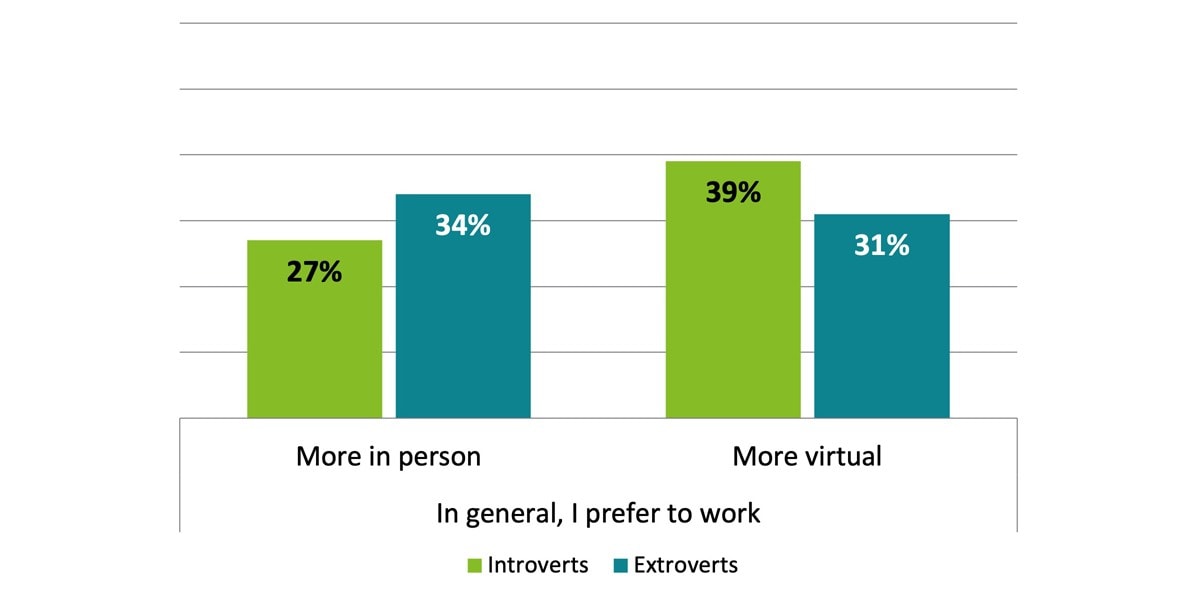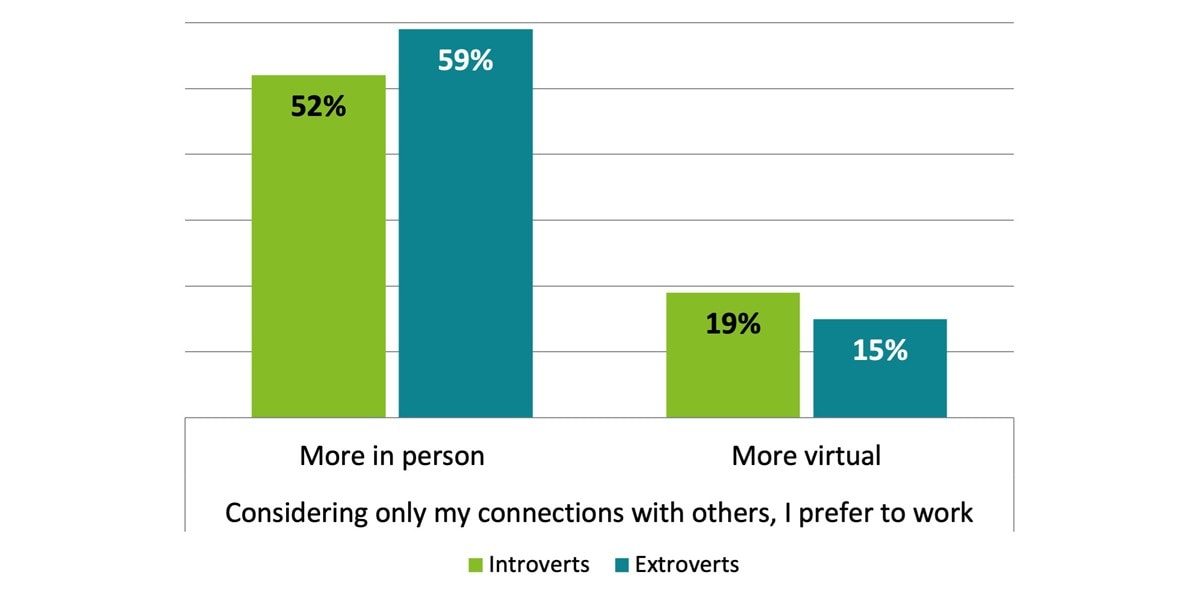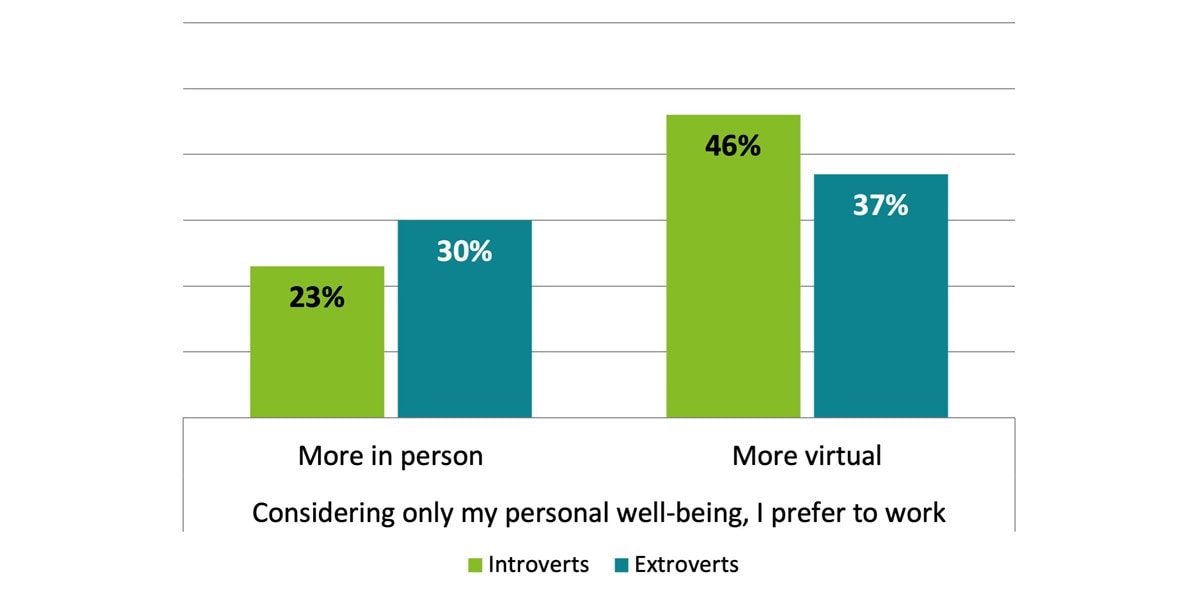Making Hybrid Work for Everyone | Deloitte US has been saved
Many companies are now (finally!) moving from virtual-first to hybrid working models, with a mix of in-person and virtual options for getting work done together. This trend means people will likely have more choice than ever before in how and where they work—good news for people’s well-being, for working across geographical boundaries, and for the bottom line. But a hybrid model presents new challenges. For one, it’s logistically difficult to bring together those who are present in person with those who remain virtual, and the result may be inequities in the experiences of these two groups. Yet efforts to make things fair—for example, conducting meetings over Zoom even when some people are physically present in the office together—may interfere with the very benefits of being together in person. At the same time, those who remain virtual will still miss out on certain activities, such as impromptu chats in the hallway or after-work drinks at a nearby bar.
All of this has led us in the Deloitte Greenhouse to wonder, what can we understand about who is more likely to return in person versus remain virtual, and how might they be affected by the resulting disparate experiences? As leaders, how can we ensure that those who remain virtual will be included in meaningful ways without inhibiting opportunities to connect for those who are present in person? And how should individuals who have the freedom to choose weigh the options and trade-offs of face time versus screen time?
So yeah. Lots of questions.
But we do have some answers. Our latest study of more than 8,000 professionals from hundreds of different organizations suggests that most people want a mix of working virtually and in person; just over 10% say they want to work almost exclusively virtually, and just under 10% almost exclusively in person. The rest are in the middle, with 22% saying they prefer a bit more in-person time, 23% a bit more virtual time, and 35% half and half.1
What’s more interesting, although perhaps not surprising, is that introverts (that’s Guardians, Dreamers, and Scientists) prefer working virtually more than in person, and more than extroverts do, while extroverts (that’s Pioneers, Commanders, and Teamers) prefer working in person slightly more than virtually, and more than introverts do.

While we might have expected that, the predictability of the pattern doesn’t make the implications of it any less impactful. If people are given a choice about how often to appear at an office in person (and I hope they will be!), these results could mean that extroverts will spend more time in the office and attending meetings and events in person than introverts will. And that matters because introverts already tend to experience more challenges than extroverts when it comes to contributing in group settings. One study we conducted with more than 11,000 professionals prior to the COVID-19 pandemic suggests introverts tend to feel less psychological safety than extroverts.
Another study we conducted, based on a sample of more than 14,000 professionals, suggests that introverts, more than extroverts, feel discouraged from contributing in a group setting when:
- People aren’t listening to each other (56% of introverts would be discouraged versus 48% of extroverts)
- Lots of people are talking at once (48% vs. 39%)
- They aren’t prepared for the discussion (33% vs. 22%)
- They’re not sure their input is welcome (23% vs. 15%)
- They don’t feel a sense of belonging (21% vs. 17%)2
I’ve written before about the “extrovert ideal,” which is prevalent in many Western business settings and which means introverts may already be viewed less favorably than extroverts. (I will keep writing about the extrovert ideal until it’s no longer true!) This effect may be exacerbated in hybrid working models if introverts don’t return to the office at the same rate as extroverts. Introverts may now feel even less accepted and less safe, and may contribute less often even than before.
Imagine a hybrid meeting with several people together in the office and several others zooming in from home. Those in the office are thrilled to be together and their energy is high. They are also, not coincidentally, quite extroverted, while the people zooming in from home are more introverted. The office extroverts have lots of opinions and ideas and they’re eager to share them. The zooming-in introverts have opinions and ideas, too, but they’re having a hard time following what’s happening. They can’t quite hear everything because the office speaker phone isn’t up to the job. And while they can see the conference room, the individual people are hard to make out. The office camera is aimed toward the whiteboard in the room, but it’s impossible to read. The office extroverts are talkative and lively. They’re riffing off each other’s ideas, interrupting, and feeding off one another’s energy. The zooming-in introverts are feeling a little left out and aren’t sure how to break into a discussion when there’s never a pause. Occasionally one attempts to speak or uses the zoom raise your hand feature, but no one notices. It feels like no one cares about their contribution and eventually they pretty much give up.
If remaining virtual means introverts have more challenges contributing, the impact could be negative for everyone, because diversity of thought makes for better decision-making and more creative problem-solving. We all benefit when introverts contribute. Moreover, extroverts, too, want a mixture of in-person and virtual work, and making a hybrid model effective is important for keeping those options open.
So what to do? It may seem a daunting knot to unravel, but it’s not impossible. Prior to the COVID-19 pandemic, many leaders thought virtual-first working models couldn’t be effective, but their people proved that they can. Hybrid models, too, can work. Our findings provide important clues for what levers to pull to make hybrid work for everyone.
- Get the technology right, so that those who attend virtually and those who are present in person can clearly see and hear each other.
- Don’t assume that a hybrid event is better than a virtual one; we’ve found it often isn’t.
- Focus on building trust and psychological safety for everyone. One path to doing so is getting to know each other more personally, which can also help with creating a sense of belonging. When opportunities to gather in person do exist, take advantage of them by making personal connections an explicit focus.
- Communicate when the goal of a gathering is connection. This may entice more people to come together in person, as our research suggests that even introverts prefer working in person for the purpose of connecting with others.

- Plan ahead and share information in advance, so that everyone has an opportunity to prepare for discussions and come ready to contribute, whether they’re attending in person or virtually.
- Make it clear that everyone’s input is welcome, and explicitly build in opportunities for those who aren’t physically present to contribute, taking turns between virtual and in-person participants, or offering asynchronous options for participation. Consider explicit roles for virtual participants to play that require others to regularly seek their input and engagement.
- If possible, pair individual virtual participants with in-person participants who can assist and be their eyes and ears in the room.
- Clearly define expectations about whether and when people should be present in person and any implications for individuals of remaining virtual when others return.
You as an individual can also:
- Request clear guidelines about what is expected regarding virtual and in-person work and what the implications may be for choosing one over the other.
- Consider how your well-being may be affected by the choices you make. In general, introverts considering their well-being indicate even stronger preferences for virtual work over in-person work. The pattern is similar, although not quite as strong, for extroverts.

- Balance considerations about your well-being with needs for connection (your own and those of your colleagues) and the need to work efficiently together.
- Ask for what you need to contribute effectively while working virtually (e.g., opportunities to prepare in advance), and also to make attending in person less stressful.
- Be an active participant in shaping how those who attend events and gatherings virtually will be meaningfully engaged.

Notes:
1 During the period of July 2021 through November 2021, all respondents who completed the online Business Chemistry assessment were asked about their preferences for virtual versus in-person work. More than 8,000 professionals from hundreds of organizations responded. Findings from this study are previously unpublished.
2 During the period of September 2020 through June 2021, all respondents who completed the online Business Chemistry assessment were asked about the conditions that would discourage them from contributing in a group setting. More than 14,000 professionals from hundreds of organizations responded. Findings from this study are previously unpublished.
Get in touch

Suzanne Vickberg (aka Dr. Suz)
Dr. Suz is a social-personality psychologist and a leading practitioner of Deloitte’s Business Chemistry, which Deloitte uses to guide clients as they explore how their work is shaped by the mix of individuals who make up a team. Previously serving in Deloitte’s Talent organization, since 2014 she’s been coaching leaders and teams in creating cultures that enable each member to thrive and make their best contribution. Along with her Deloitte Greenhouse colleague Kim Christfort, Suzanne co-authored the book Business Chemistry: Practical Magic for Crafting Powerful Work Relationships as well as a Harvard Business Review cover feature on the same topic. She also leads the Deloitte Greenhouse research program focused on Business Chemistry and is the primary author of the Business Chemistry blog. An “unapologetic introvert” and Business Chemistry Guardian-Dreamer, you will never-the-less often find her in front of a room, a camera, or a podcast microphone speaking about Business Chemistry or Suzanne and Kim’s second book, The Breakthrough Manifesto: Ten Principles to Spark Transformative Innovation, which digs deep into methodologies and mindsets to help obliterate barriers to change and ignite a whole new level of creative problem-solving. Suzanne is a University of Wisconsin-Madison graduate with an MBA from New York University’s Stern School of Business and a doctorate in Social-Personality Psychology from the Graduate Center at the City University of New York. She is also a professional coach, certified by the International Coaching Federation. She has lectured at Rutgers Business School and several colleges in the CUNY system, and before joining Deloitte in 2009, she gained experience in the health care and consulting fields. A mom of two teenagers, she maintains her native Minnesota roots and currently resides in New Jersey, where she volunteers for several local organizations with a focus on hunger relief.
